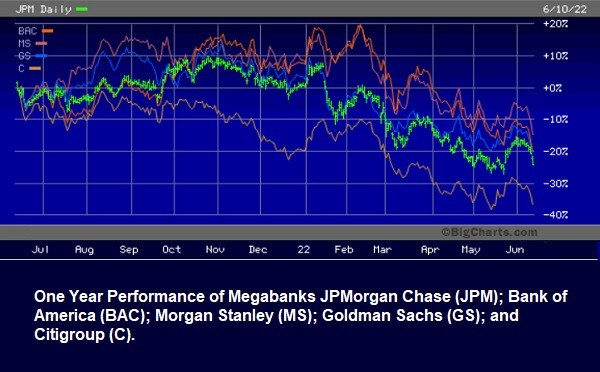By Pam Martens and Russ Martens: June 13, 2022 ~
Welcome to Monday morning and market hell.
As of 8:47 a.m. (ET) this morning, Dow futures are down 553 points; Bitcoin futures have lost 17 percent of their value on the news that cryptocurrency lender, Celsius Network, has frozen withdrawals. The 5-year Treasury note has spiked to yield 3.38 percent, a 50-basis point increase in a month, leading to an inverted yield curve against the 10-year Treasury note, which is trading at 9:01 a.m. (ET) this morning at a yield of 3.27 percent. (An inversion signals a rising recession risk.)
All of this comes as the Fed has signaled that it will announce another interest rate hike this Wednesday, following the two-day meeting of its Federal Open Market Committee (FOMC). Stocks are developing a habit of tanking one day after Fed Chair Jerome Powell holds his FOMC Wednesday afternoon press conference, so watch out for stock market activity this Thursday.
The Fed has also announced that on Thursday of next week, June 23, at 4:30 p.m. (after the stock market closes) it will announce the results of its stress tests of the G-SIBs, the Global Systemically Important Banks. It can’t be too comforting to the Fed that the same banks that cratered the global economy in 2008, and required a mind-blowing $29 trillion bailout, have a lot less capital than they had one year ago.
As of last Friday’s closing prices, five U.S. megabanks that constitute the core of the U.S. financial system have $300 billion less common equity market capitalization than they had one year ago on June 10, 2021.
Citigroup, which has fared the worst of the lot in terms of percentage decline, is down 38 percent year-over-year with a market cap plunge of $56.6 billion. JPMorgan Chase’s share price is down 25 percent year-over-year but its market cap loss makes Citigroup look like a piker. JPMorgan Chase has seen its market cap evaporate by $120 billion in one year. That’s because it has a bizarrely large 2.94 billion shares outstanding that have been bleeding.
Bank of America has lost 20 percent year-over-year with a market cap loss of $68.67 billion. Morgan Stanley is down 16 percent year-over-year for a market cap loss of $25 billion; and Goldman Sachs has given up 23 percent year-over-year with a market cap decline of $29.85 billion.
The five megabanks that the Office of Financial Research says make up the core of the U.S. financial system have lost a combined $300 billion in market cap year-over-year and the Fed is still tightening monetary policy.
But that’s not even the worst of the news. U.S. megabanks are heavily interconnected to foreign megabanks through trillions of dollars in notional derivatives. Despite the economic devastation in 2008 from derivatives, the Fed and Congress have continued to allow foreign megabanks to serve as counterparties to U.S. megabanks’ derivatives. (U.S. megabanks also serve as counterparties to each other’s derivatives.)
The share prices of foreign megabanks are doing even worse than those of U.S. megabanks. Credit Suisse’s ADR closed on Friday on the New York Stock Exchange at $6.17, a year-over-year decline of more than 40 percent. Nomura has lost more than 30 percent year-over-year while the serially-troubled Deutsche Bank, which was a $120 stock in 2007, closed on Friday in New York at $9.98.


